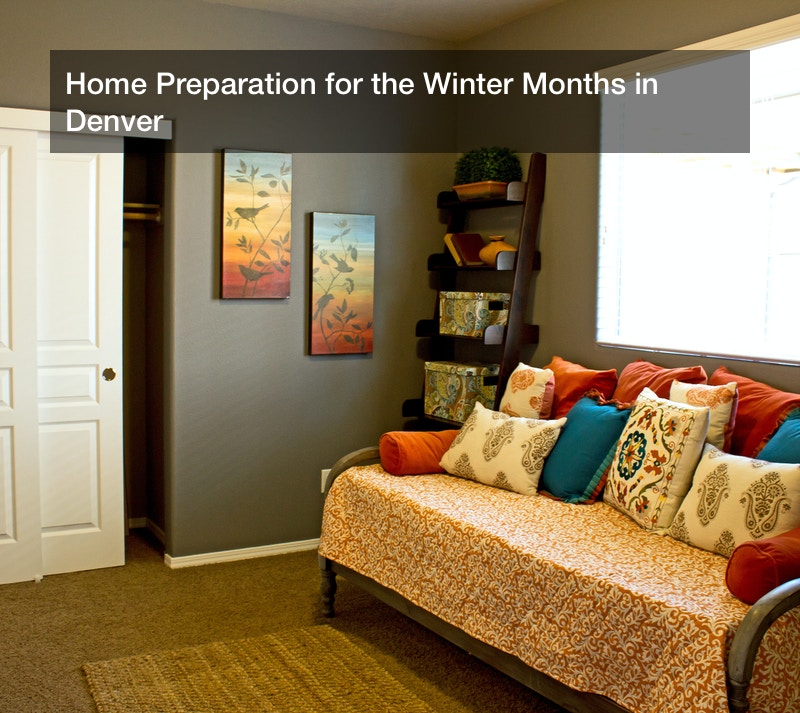Home Preparation for the Winter Months in Denver

As temperatures begin to drop, Denver residents might begin to wonder what to expect from the upcoming season.
Colorado winters are fairly mild, especially compared to other areas of the country. But that doesn’t mean you can skip out on prepping your home for the winter months. Yes, the average daily high temperature is around 45 degrees Fahrenheit, but overnight temperatures can drop down into the mid-teens. In addition, Colorado’s average snowfall is around 57 inches per year, which is higher than the national average.
With all that in mind, you’ll want to take some steps to winterize your home as autumn draws to a close. But where should you start? Here’s a guide to several tasks you should consider undertaking sooner rather than later.
Checking for Drafts
Drafts can ruin your attempts to make your living space warm and toasty. Your heating system will also have to work harder if air leaks aren’t sealed. The end result will be an unnecessary uptick in your monthly energy bills.
Make it your mission to find as many leaks as possible. Plenty of spots could be letting cold air in, but pay extra attention to the following:
- Attic hatches
- Baseboards
- Electrical outlets
- Every door leading to the outside
- Fans (such as those in a bathroom)
- Fireplace
- Light fixtures
- Vents (such as stove vents)
- Window frames
Carry a lit incense stick with you as you examine each potential leak. Keep your eyes on the smoke drifting off the stick. Is it moving in a way that indicates air is blowing?
If you don’t want to use incense, you can simply dampen your hand and place it in front of a possible leak. You should be able to easily detect leaks this way.
No matter which method you’re using to find drafts, conduct the test on a windy day and keep a notebook handy to record your findings.
Sealing Leaks
Sealing up leaks is easy, but you’ll need to have the right tools handy. A draft stopper is a smart and quick solution for handling leaks near doors. These come in various shapes and sizes, so you have plenty of options. For example, some are available in silicone rubber, and others are fleece.
Use caulk to seal up cracks that are smaller than 1/4th inch, but consider using spray foam for larger cracks. For the strongest seals, make sure you closely follow the instructions that come with each product.
Windows: Seal or Replace?
Windows require special attention. That’s because, in average homes, a large amount of heat is lost through leaky windows. There are several solutions, and the best answer depends on the severity of the draft.
In addition to using the aforementioned caulk or spray foam to seal small cracks along the window frame, you can use a plastic film covering to cover the entire window. Some plastic film coverings can be held up with temporary adhesive, and others form an airtight seal when a source of heat, such as a hair dryer, is used.
In some cases, a plastic covering may not be enough to stop drafts. If your windows are older, consider replacing them with new models. This will definitely be more expensive than a simple covering, but the update can also add value to your home in the long run.
Clearing Your Sprinkler System
Blowing out your sprinkler system is an important part of winterizing your home. If water is left in the system, the water can freeze and cause damage as it expands.
To remove water from the system, you’ll need an air compressor, which you can either rent or buy from a hardware outlet. Carefully follow the compressor’s instructions as you clear the sprinklers. If you use too much of a charge, you can damage your system. Also, keep in mind that acids are the primary reason compressor fluids fail. Maintaining low acid levels slows these destructive forces and increases fluid service life.
You’ll know when the system is fully blown out when the water spurting out turns into a mist.
Check Your Heating System
Your heating system will be a vital tool for staying toasty all winter long. So, it only makes sense that you give it plenty of attention before the cold weather sets in.
Reach out to a service that offers furnace repair in Denver so experts can examine your system before you put it to work. This will help minimize the risk of your system breaking down when you need it most.
While you’re waiting for the scheduled checkup, you can perform a little maintenance on the furnace yourself. Start by simply testing out the thermostat to ensure it’s working properly. If there seems to be an issue with the furnace coming on, you might need to test the ignitor switch or the associated breaker.
The problem could be that the pilot is out, in which case you’ll have to relight it is using the reset button and a long lighter. Although this is a fairly easy process, research the specific steps to take to avoid injury or damage to the system. If you don’t feel confident handling the task, wait for a professional to help.
Another furnace-related task you can tackle without a professional is replacing the filter. The most important things to keep in mind when doing this are:
- Make sure you buy a filter that fits the existing system. In some cases, a furnace will have a reusable filter that you simply have to clean and reinsert.
- Make sure you put the filter in correctly. If you put it in backwards, you might accidentally block airflow.
Other Preparations
While the above tasks cover a few winterization strategies, there’s plenty of other work to be done as well. For example, not everyone has an outdoor space for entertaining guests, but if you do, be sure to take care of your patio furniture. Clean off your chairs, cushions, and tables before putting them into storage. You might also consider covering your entire deck with a tarp if you don’t want to put your furniture in a storage space.
Because winter comes with a decrease in sunlight, you should consider cleaning glass light fixtures around your home as well. Replace any lightbulbs that have blown out, otherwise you’ll be spending extra time in the dark.





